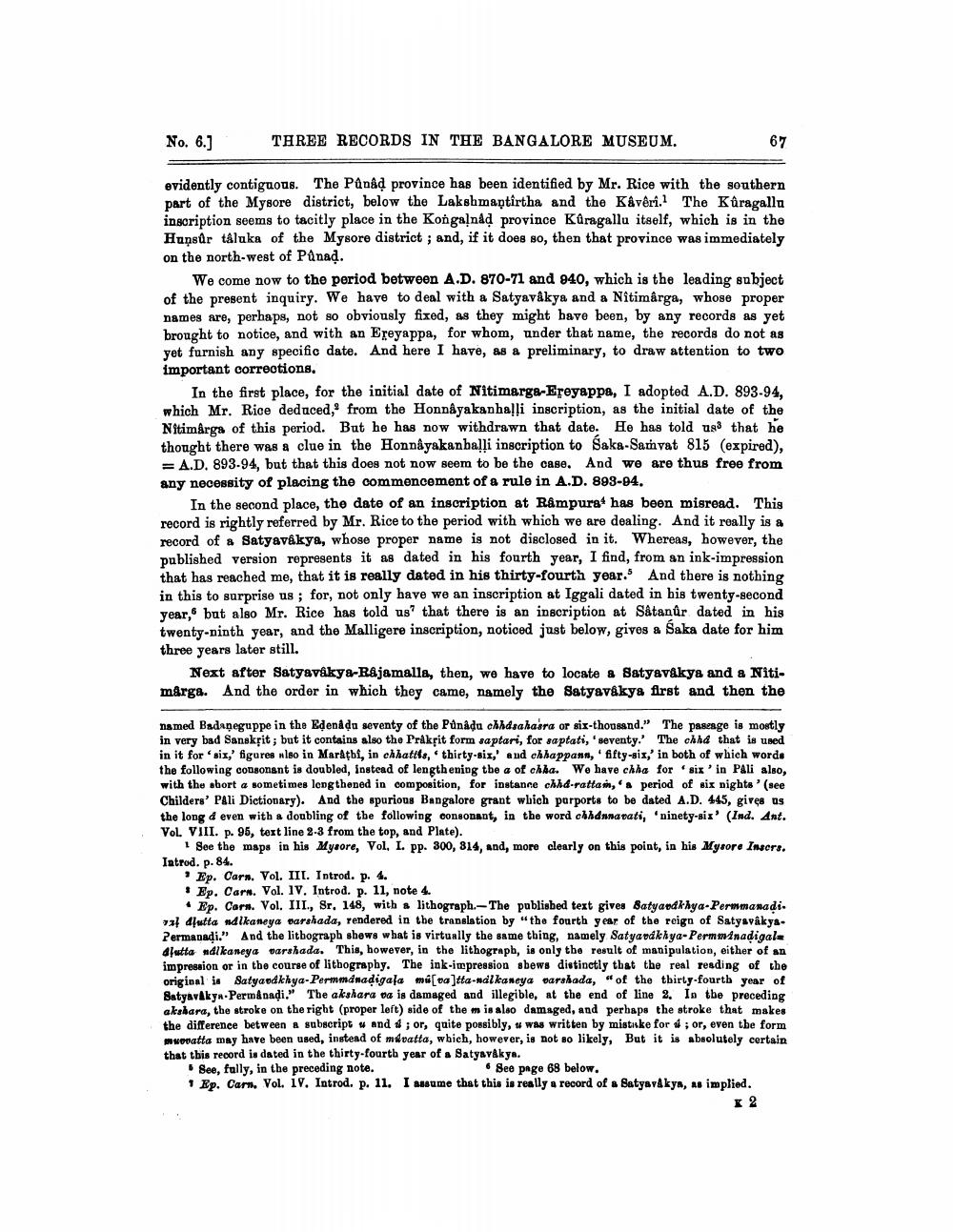________________
No. 6.]
THREE RECORDS IN THE BANGALORE MUSEUM.
67
evidently contiguous. The Panad province has been identified by Mr. Rice with the southern part of the Mysore district, below the Lakshmaptirtha and the Kávêri. The Kûragallu inscription seems to tacitly place in the Konga!nad province Kûragallu itself, which is in the Huņsûr tâluka of the Mysore district ; and, if it does so, then that province was immediately on the north-west of Panad.
We come now to the period between A.D. 870-71 and 940, which is the leading subject of the present inquiry. We have to deal with a Satyavákya and a Nitimârga, whose proper names are, perhaps, not so obviously fixed, as they might have been, by any records as yet brought to notice, and with an Ereyappa, for whom, under that name, the records do not as yet furnish any specific date. And here I have, as a preliminary, to draw attention to two important corrections,
In the first place, for the initial date of Nitimarga-Ereyappa, I adopted A.D. 893-94, which Mr. Rice deduced, from the Honnayakanhalli inscription, as the initial date of the Nitimarga of this period. But he has now withdrawn that date. He has told us that he thought there was a clue in the Honnayakanhalli inscription to Saka-Samvat 815 (expired), = A.D. 893-94, but that this does not now seem to be the case. And we are thus free from any necessity of placing the commencement of a rule in A.D. 893-94.
In the second place, the date of an inscription at Râmpurahas been misread. This record is rightly referred by Mr. Rice to the period with which we are dealing. And it really is a record of a Satyavákya, whose proper name is not disclosed in it. Whereas, however, the published version represents it as dated in his fourth year, I find, from an ink-impression that has reached me, that it is really dated in his thirty-fourth year. And there is nothing in this to surprise us ; for, not only have we an inscription at Iggali dated in his twenty-second year, but also Mr. Rice has told us that there is an inscription at Satanûr dated in his twenty-ninth year, and the Malligere inscription, noticed just below, gives a Saka date for him three years later still.
Next after Satyavákya-Rajamalla, then, we have to locate a Satyavákya and a Nitimarga. And the order in which they came, namely the Satyavákya first and then the
named Badaneguppe in the Edenåda seventy of the Punadu chhdsahasra or six-thousand." The Pageage is mostly in very bad Sanskrit; but it contains also the Prakrit form saptari, for saptati, seventy. The chha that is used in it for six,' figures leo in Marathi, in chhatils, thirty-six,' aud chhappann, 'fifty-six,' in both of which words the following consonant is doubled, instead of lengthening tbe a of chha. We have chha for six ' in PAli also, with the short a sometimes lengthened in composition, for instance chid-rattan,& period of six nights' (see Childers' PAli Dictionary). And the spurious Bangalore grant which parports to be dated A.D. 445, gives us the long d even with a doubling of the following consonant, in the word chhdnnarati, ninety-six' (Ind. Ant. Vol. VIII. p. 95, text line 2-3 from the top, and Plate).
1 See the maps in his Mysore, Vol. I. pp. 300, 814, and, more clearly on this point, in his Mysore Inscrs. Iatrod. p. 84.
Ep. Carn. Vol. III. Introd. p. 4.
Ep. Carn. Vol. IV. Introd. p. 11, note 4. • Ep. Carn. Vol. III., Sr, 148, with a lithograph. The published text gives Satyandkhya-Permmanadi. 31 dlutta ndlkaneya varshada, rendered in the translation by "the fourth year of the reign of SatyavákyaPermanadi." And the litbograph shows what is virtually the same thing, namely Satyavdkhya-Permminadigala alutta ndlkaneya warshada. This, however, in the lithograph, is only the result of manipulation, either of an impression or in the course of lithography. The ink-impression sbews distinctly that the real reading of the original is Satyandkhya-Permmdnadigala mú[va]tta-nalkaneya warshada, "of the thirty-fourth year of Batyavákyn. Permånadi." The akshara na is damaged and illegible, at the end of line 2. In the preceding akshara, the stroke on the right (proper left) side of the m is also damaged, and perhaps the stroke that makes the difference between a subscript w and 4;or, quite possibly, # was written by mistake for ; or, even the form pwonatta may have been used, instead of mavatta, which, however, is not so likely, But it is absolutely certain that this record is dated in the thirty-fourth year of a Satyavákya. . See, fully, in the preceding note.
See page 68 below. 1 Ep. Carn, Vol. 1V. Introd. p. 11. I assume that this is really a record of a Satyavákya, as implied.
I 2




